Examining the myth of Mayahuel
“We are what we tell ourselves that we are and a nation is, in essence, just faith in a story.” Tomás Pérez Viejo
In the lead up to the 500 year anniversary of the “Conquest of Mexico”, the Mexican government took an important step to change how the story and myth of the Spanish conquest has been framed. In March last year, Mexican President Lopez Obredor sent a letter to the government of Spain and to Pope Francis urging them to apologize for human rights abuses committed during the conquest. This request served as the framework of a new narrative promoted by his government and a national debate around the commemoration of the fall of México-Tenochtitlan, or Conquest of Mexico. This year, however, the event was rebranded and on August 13th, we celebrated “the resistance of our indigenous people,” and was a strong statement from the Mexican government to recognize the struggle and suffering of the original people of Mexico from when the Spaniards invaded their territories and all the events that came after.
In both US and Mexico societies, scholars, students and community leaders are re-examining and questioning the perspectives and versions of history that have been taught over time. Specifically for Mexico, in the wake of the Spanish conquest, stories that up until today have been taught through the eyes and languages of others. This does not only apply to foundational myths, political figures or historic events but also to the cosmovision of indigenous peoples. Such is the case of Mayahuel, as revealed in a recent article by Dr. Rodolfo Rodriguez, a Mexican historian who has studied the evolution of pulque throughout history. He questions whether the concept of this goddess was “whitewashed” as result of a mistranslation of her name and origins. This begs the question, what If everything we have learned about her history is not accurate and the origin story that has become so firmly entrenched in the selling of mezcal, may not be what we think it is?
The Mayahuel myth
Finnish professor Sirrka Ahonen once said, “A myth is born when a community embraces a narrative as an integral element of its collective memory,” Myths provide us with a foundation and understanding of the unknown. They are stories to tell that appeal to our identity. It is only natural that debunking a myth is a controversial topic, as it calls into question the foundation upon which a national identity has been built.
According to Rodríguez, there are two different myths of Mayahuel. It is unclear exactly whether the Otomi, Huastec or Olmec, ancient Mesoamerican empires, birthed the story of Mayahuel. The first story is about the origin of pulque and involves two characters: one is Mayahuel as a woman, the first who made aguamiel from the sap of the agave. In order to have done this she would have needed to know the plant as well as the process of removing the quiote and scraping the inside to get the sap out. She is seen as Patécatl’s husband, the creator of octli which is the medicine of pulque. Their divine knowledge of getting the aguamiel and fermenting it, led to them being granted the goddess and god standing. Their sons are known as Centzontotochtin or the 400 rabbits (Tepoztecatl, Cuatlapanqui, Tliloa and Papaztac among others) who are also recognized as minor deities that represent the different states of drunkenness.
The second story is the most popular since it is related to the agave plant creation. A virgin goddess who lived in the cosmic heaven wished to travel to Earth. Ehécatl-Quetzalcoatl, the God of wind, aware of her wish, went to see her to make the trip together and they once arrived on Earth, they fell in love and were transformed into two flowering and intertwined trees. When her sisters and grandmother, known as the Tzitzimime, heard of their journey to earth, they went in search of them. When they found her, she had transformed into a plant and they ripped her from Quetzalcoatl’s tree. After breaking her into pieces, the Tzitzimime ate her. Quetzalcoatl returned to his original shape, picked up the remaining pieces and then buried them. Because Quetzalcoatl was aware of the human need to enjoy life, he wanted them to have joy in their hearts and to remember Mayahuel, he transformed her into a plant with 400 breasts or leaves. Both myths correspond to Mayahuel’s nature and are complementary one to the other.
Where Rodriguez’s thesis becomes controversial is when he states that Mayahuel is not the goddess of maguey. By citing historic documents and chronicling where Mayahuel is mentioned and shown through a number of representations, he suggests that “maguey goddess” is a mistranslation of Nahuatl to Spanish. His analysis demonstrates the different interpretations of the names of gods and goddesses that represent the maguey. For example, he cites documents such as the Mexican Chronicle of 1598 where Meteotl is said to be the god of maguey and research by Belgian historian Michel Graulich in which he uses the name Mecitli, not Centzontotochtin, in talking about the maguey’s rabbit, who fed the different gods of pulque. Rodriguez cites Histoire du Mexique as the first document where the name Mayahuel appeared and states that this translation was used in other texts throughout the years, and became the formally accepted name by other historians and sources. It is with that European translation where he questions its veracity. For Rodriguez, the meaning of Mayahuel is closer to a representative of maguey or the discoverer of the agave sap or aguamiel, than to a deity.
Unlike myths surrounding personalities such as Columbus and Hernan Cortés, I don’t remember learning anything about Mayahuel in school, and even though I studied the Aztec calendar I did not delve into the various deities of every pre Hispanic culture. Reading Rodriguez’s interpretation of the Mayahuel myth made me realize how much my history classes focused not only on the years after the conquest, but also how the perspective we have been taught has been through a European perspective because of how the language of the indigenous cultures was translated.
A different perspective
Victor Urbano, co-owner of Tlamati Mezcal, grew up in Altepexi, Puebla and was raised speaking both Nahuatl and Spanish as his first languages. He and his family moved to Mexico City when he was ten and his curiosity took him on a self-learning journey in which being a Nahuatl speaker gave him a better access into understanding the history of pre hispanic Mexico. He now documents the recipes of his mom, a traditional cook, and has been very involved in the mezcal world and actively promotes the nahua language. He gave me his own interpretation of the matter around Mayahuel, “if the name is grammatically incorrect it doesn’t change anything about what the deity represents”.
According to Urbano’s view, goddesses related to Earth are given different names according to the different stages they inhabit. Therefore, Mayahuel, like Tlazoteotl (the goddess of vice) and Coatlicue (the Aztec earth goddess) are all part of Tonantzin, or the mother earth. We cannot talk about their being a singular fertility goddess, because she is part of a whole. This idea lived on following the conquest as represented in the Virgin of Guadalupe who was easily adopted by our native people as an advocate of Mother Earth, Tonantzin.
Rodriguez’s controversial thesis only referred to documents written by European historians and did not include any discussion of the Borgia Codex which was written before any European contact in Mesoamerica. This pictorial manuscript is generally regarded as a divinatory almanac based on the tonalpohualli or “count of days” a ritual calendar with twenty periods of thirteen days each (trecena). Every trecena is ruled by a deity, for example, the seventh trecena scene (known as 1-malinalli) depicts Mayahuel, a pulque vessel and a pulque drinker all framed within a rectilinear border displaying the day signs included in the trecena. See the image below.
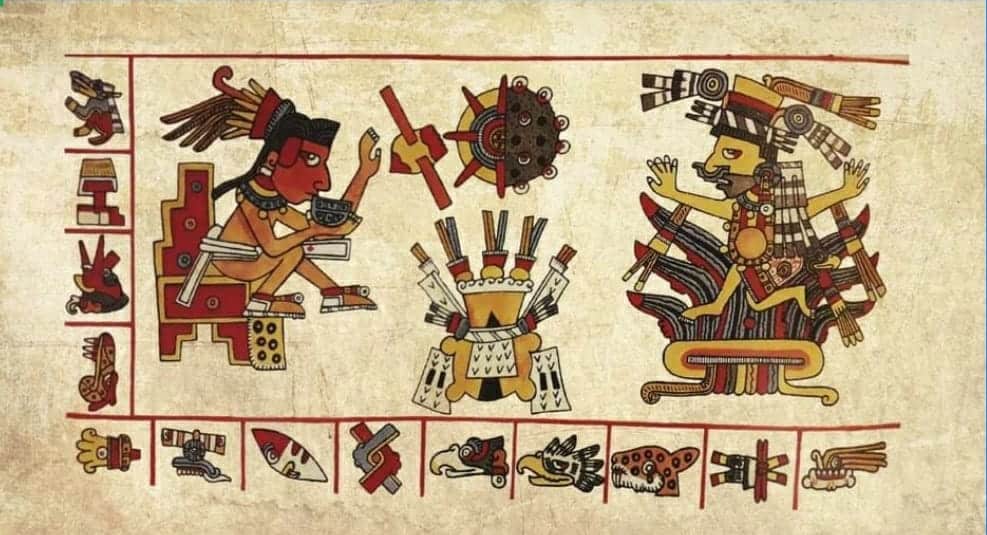
Nor does he reference other pictorial codices such as Laud and Vaticano B, which have allowed different historians, archaeologists and experts to study Mayahuel images in many of its variations. According to researcher Richard Guzmán in his paper “Mayáhuel: Mesoamerican deitess of the maguey, as depicted in the Codex Borgia”, “She was associated with the arts and entertainment through the artistic and alcoholic conventions of the maguey plant, but was simultaneously considered an agrarian deity of nourishment and sustenance through the gastronomic and domestic uses of the agave. Mayahuel specially served as a symbol of fertility and feminism, reaffirmed in her various avatar illustrations and the accompanying iconography.”
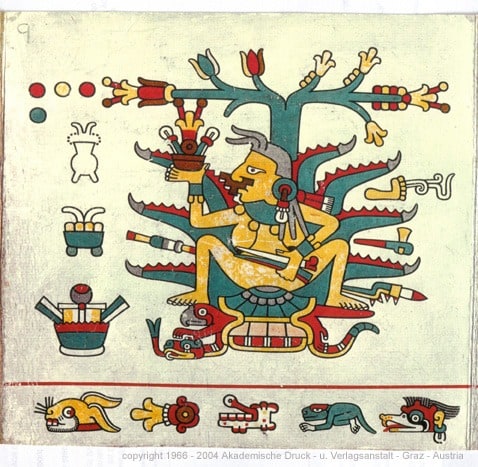
Urbano explained some of these images based on his personal interpretation of the image found in the Laud Codex.
- A turtle and a serpent, both are animals directly related to Tonantzin since one lives in the water and the other one, on earth.
- Judging from her position, Mayahuel is giving birth which symbolizes fertility and puts her as the goddess of life, she is the advocation of mother earth creating life.
- The foot on the side represents birth, the arrival to this world. The absence of the right foot means it hasn’t left the spiritual world yet. This is a way to depict the material world and the spiritual one.
- She is holding a vase that contains pulque, the ferment of life which at the same time is the transition between the spiritual and the material life. Aguamiel is also the milk that she needs to produce octli, the fermented drink.
In the image below, we see Mayahuel again whose fertility is symbolized nursing a fish. She is also wearing a malacate on her head, an iconic headdress also present in representations of Tlazolteotl and Patecatl. A malacate is a circular artifact made out of clay with a hole in the middle where a spindle is set up. According to philologist Katarzyna Mikulska in her paper Tlazoltéotl, Una Diosa del Maguey, “spinning and weaving were activities reserved for women and it had an important symbolic meaning based on the influence of the Moon over the functioning of the entire world. Such influence is determinant for the ocean currents and the rain, the female cycles, fertility and the development of all living beings. In that sense, the meaning of the malacate symbolizes the weaving of life, from beginning to end. This artifact together with a half moon nose ring or yacametztli were used to depict deities, both of which are present in Tlazolteotl and Mayahuel, meaning that both of them are life weavers.”
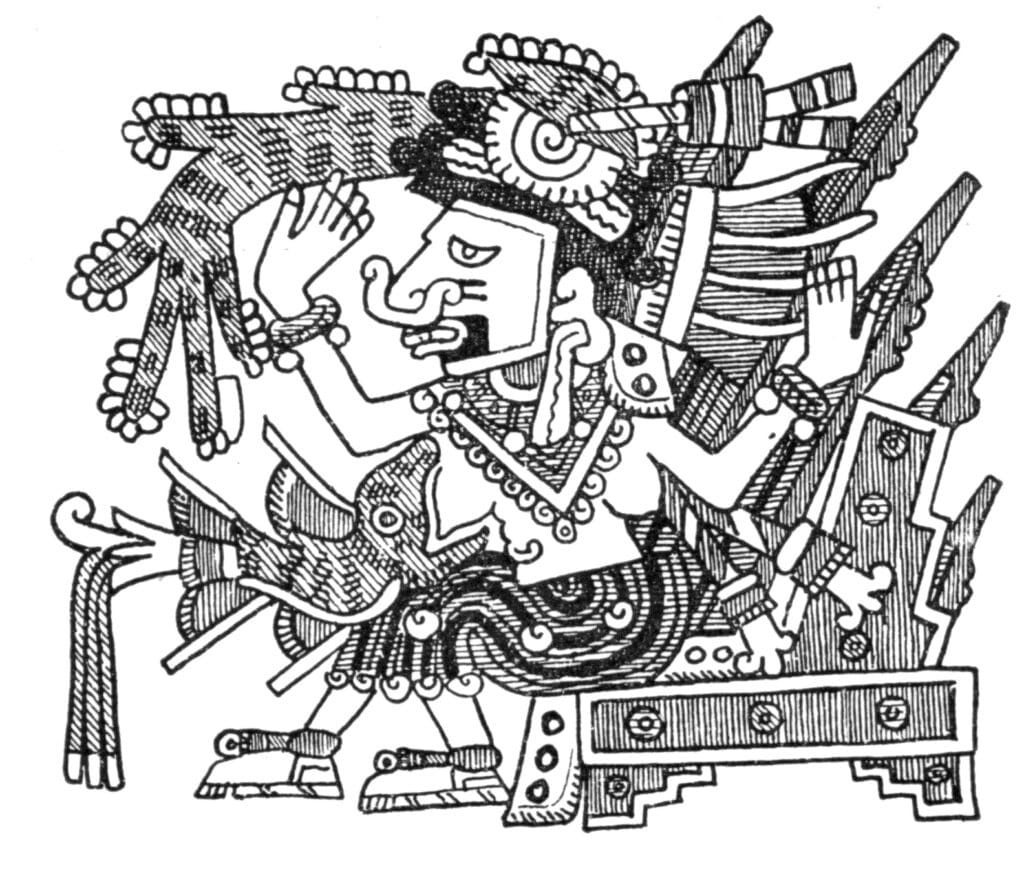
In order to better understand the representations of Mayahuel and the various meanings around her, I reached out to Francisco Hernández Maciel, an independent researcher who studies the Nahua calendar, to help explain the significance of having multiple myths about the goddess. Just as Urbano mentioned, Hernandez says that Mayahuel is both a woman and a virgin. And as Mikulska also established, the essence of Mayahuel is connected to Tlazolteotl and other celestial entities or cihuateteo which means divined women. What these myths tell us is that after her death, Mayahuel transformed into a new entity which is the essence of maguey. Her achievement as a woman was to discover how to scrape the center of the maguey to obtain the sap or aguamiel.
What’s in a name?
As I go through many papers related to Mayahuel, it is clear there is also a confusion in the roots of the name and how it has been translated. According to Guzman, the name Mayahuel comes from the Nahuatl words metl meaning “maguey” and yohualli meaning “round” or “encircling”, which could roughly translate to “one who surrounds the maguey”. However, the Great Nahuatl Dictionary says yohualli means “night”. Rodriguez on the other hand, uses yahualli concluding that the correct name should be Meyehual and translated into “the divine spirit surrounded by maguey.”
But Hernandez Maciel explains that Meyehual is not a correct use of words because grammatically, it should read Meyahualli, and in keeping with how the names of goddesses are structured, Meyahualtzin (again the similarity with Tonantzin). In this structure, the root word seems to connect with the idea of roundness, but in fact the word yahualli actually refers to the cover of a pot. The correct word for the verb “surround” or “be surrounded” is yahualoa, the root in creating the word yahualo, and a variant yahualihui.
In Nahuatl, the composition of words establishes that the first term modifies the second. For example, if we take meyahualli, the noun is yahualli and it is modified by metl as indicated by me. The meaning would seem to designate an object with the shape or something related or similar to the maguey. But for Hernandez Maciel, there are two nouns in the same word and that is a grammatical inconsistency. In his opinion, the word menahuac would be the word used by a native Nahua speaker from the 16th century , nahuac means “surrounded by ”. He concludes that Mayahuel is itself an archaic expression with an indeterminate meaning because grammatically, it is an irregular word. Even if there is a move to name her correctly, the essence of what we know about Mayahuel as the goddess of maguey, would not change.
Both Urbano and Hernandez Maciel agree that Rodriguez is correct in exposing the problematic eurocentric translation of Mayahuel, but they disagree with his conclusion that the mistranslation takes away a deity attribute because there are multiple references to her importance in a wide array of cultural representations.
I do believe though that we have been sold a simplified story of Mayahuel, one adapted to the needs of the market, shortened to the length of a label, making it easier to fall for the controversy around this research paper rather than the substance. I can only think, after this brief lesson about deities and Nahuatl, that judging history from our present leaves us with a simple layer of what we observe.
Has the history of Mayahuel been simplified to push consumption of mezcal? Has it made us romanticize and fall in love with her mystique? The origins of the goddess are as complex as the spirit, the concept itself profound much like the history of Mexico. As Rodriguez himself states in one of his articles regarding pulque, “the greater impact of the Conquest was that the ritual drink got so popular that people forgot its mythical and religious content, starting a prosperous commercial business which gave fortune to many Spanish families. But also, put it into oblivion among Mexicans. The drink went from being part of a ritual to become a cheap drink to calm hunger, pain and exploitation among the indigienous and mestizo population.”
If we tend to over simplify our history it is for practical reasons, to have a better understanding of our reality even if it means it might be used for political or commercial purposes. Therefore it is our obligation to question and find our sense of belonging beyond what is officially told, even if it means debunking some cherished myths.


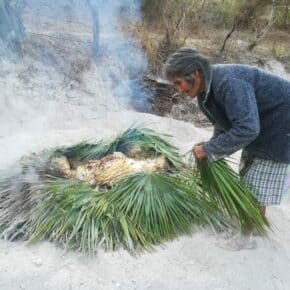
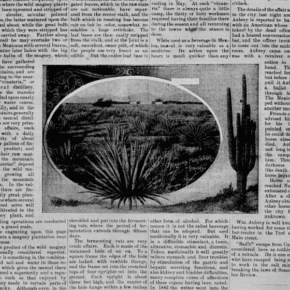









Wow, this is deep and heavy AF!!
Thank you for putting so much time in to this kind of research!
It’s a very interesting article, quite confusing because there may be other
Interpretations, altho, they are similar.
I don’t understand why that plant was
so important? Didn’t they have other food.?
Ask you can tell, I know nothing about this.
Awesome article! Thank you so much for the thorough research!